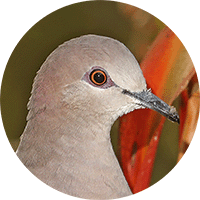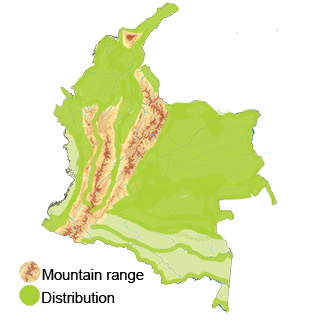White-tipped Dove
The White-tipped Dove (Leptotila verreauxi). Read in Spanish
Appearance: The White-tipped Dove (Leptotila verreauxi) is a medium-sized, plump dove species with a distinctive white-tipped tail, giving it its name. It has a predominantly brownish-gray plumage with a hint of pinkish hue, a pale grey head, and a white band on the tip of the tail feathers. This species has red eyes, a pinkish bill, and pink legs, adding to its overall soft and gentle appearance.
Habitat: White-tipped Doves prefer to inhabit a variety of forested habitats, including tropical and subtropical forests, woodlands, scrublands, and forest edges. They can also be found in agricultural areas, gardens, and parks, especially where there is access to water and ample vegetation for nesting and foraging.
Behavior: White-tipped Doves are typically ground-feeders, foraging for seeds, fruits, and insects on the forest floor. They are often seen in pairs or small groups, moving quietly through the undergrowth or perching in trees. These doves have a soft, melodious cooing call that can often be heard in their habitat.
Breeding: The breeding season for White-tipped Doves varies by location but generally occurs during the rainy season or times of abundant food. They build flimsy nests of twigs, leaves, and vines in trees or shrubs, where the female usually lays one or two eggs. Both parents take turns incubating the eggs and caring for the young chicks once they hatch.
Conservation Status: The White-tipped Dove is relatively common and widespread throughout various regions, including lowland and foothill forests. It is considered of least concern by the International Union for Conservation of Nature (IUCN) due to its wide distribution and stable population.
Distribution
The White-tipped Dove (Leptotila verreauxi) is distributed across various regions of Colombia, where it can be found in a range of habitats, from lowland tropical forests to forest edges, agricultural areas, and urban settings.
Amazon Region: In the Amazon region of Colombia, White-tipped Doves are present in the dense tropical rainforests and adjacent areas. They can be found in the departments of Amazonas, Caquetá, Guainía, Guaviare, Putumayo, and Vaupés.
Andean Region: In the Andean region, White-tipped Doves inhabit the foothill forests, cloud forests, and forested areas along the eastern and western slopes of the Andes Mountains. They can be found in departments such as Antioquia, Valle del Cauca, Risaralda, Caldas, and Tolima.
Caribbean Region: Along the Caribbean coast of Colombia, White-tipped Doves can be found in areas with suitable habitat, including forests, woodlands, and gardens. They are present in departments such as Atlántico, Bolívar, Cesar, Magdalena, and La Guajira.
Orinoquía Region: In the vast plains of the Orinoquía region, White-tipped Doves are found in woodlands, savannas, and riparian areas. They occur in departments such as Arauca, Casanare, Meta, and Vichada.
Pacific Region: Along the Pacific coast of Colombia, White-tipped Doves inhabit coastal forests, mangroves, and forested areas. They can be found in departments such as Chocó, Cauca, and Valle del Cauca.
Central Region: In the central part of Colombia, White-tipped Doves are present in a variety of habitats, including forests, agricultural areas, and urban environments. They occur in departments such as Cundinamarca, Boyacá, and Huila.
Taxonomy
The White-tipped Dove (Leptotila verreauxi)
- Kingdom: Animalia
- Phylum: Chordata
- Class: Aves (Birds)
- Order: Columbiformes
- Family: Columbidae
- Genus: Leptotila
- Species: Leptotila verreauxi
Vocalization
The White-tipped Dove (Leptotila verreauxi) is known for its melodious and distinctive vocalizations.
- Cooing Call: The White-tipped Dove produces a soft, rhythmic cooing call that is often described as a gentle, repetitive "coo-oo-oo" sound. This call is pleasing to the ear and can be heard throughout the day, especially in the early morning and late afternoon when the doves are most active.
- Advertising Call: During the breeding season or when establishing territories, White-tipped Doves may produce a more elaborate cooing call to attract mates or communicate with other doves. This call may be accompanied by wing-flapping displays or other visual signals to convey information to neighboring doves.
- Contact Calls: White-tipped Doves also use soft, mellow contact calls to communicate with their mates or family members while foraging or moving through their habitat. These calls help maintain contact within a group and ensure individuals stay connected while dispersed in the vegetation.
- Alarm Calls: When startled or threatened, White-tipped Doves may emit short, rapid alarm calls to alert others in the group to potential danger. These alarm calls serve as a warning to the group and help coordinate responses to threats or predators in the environment.




